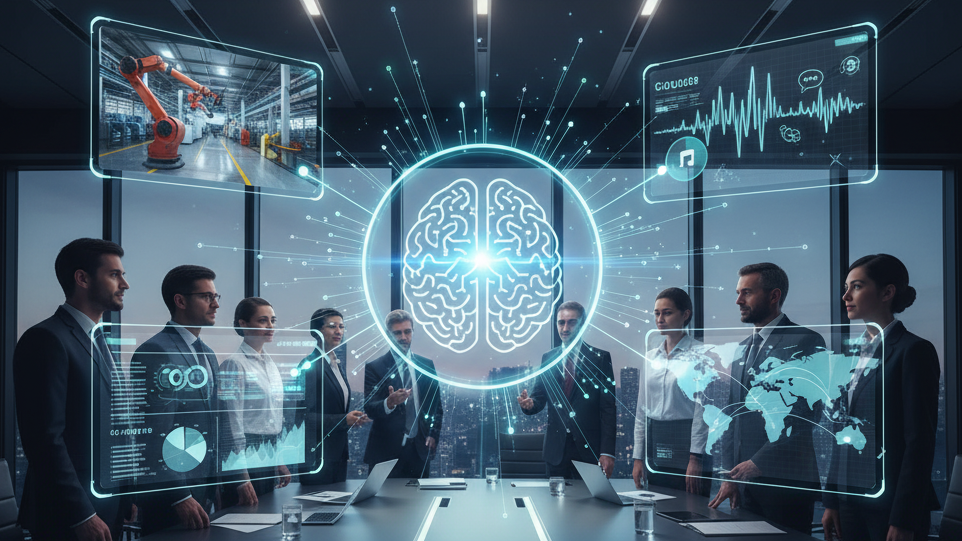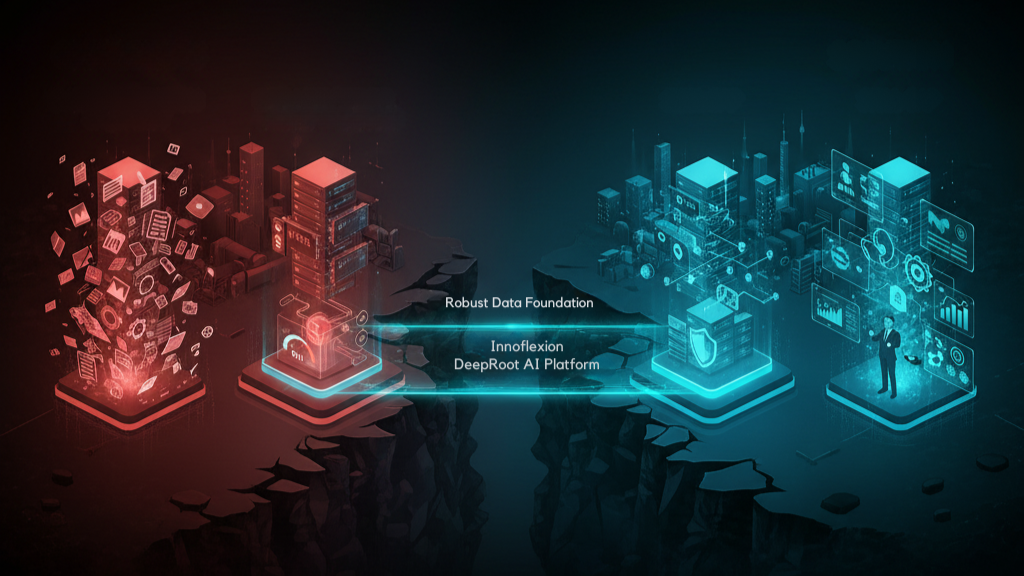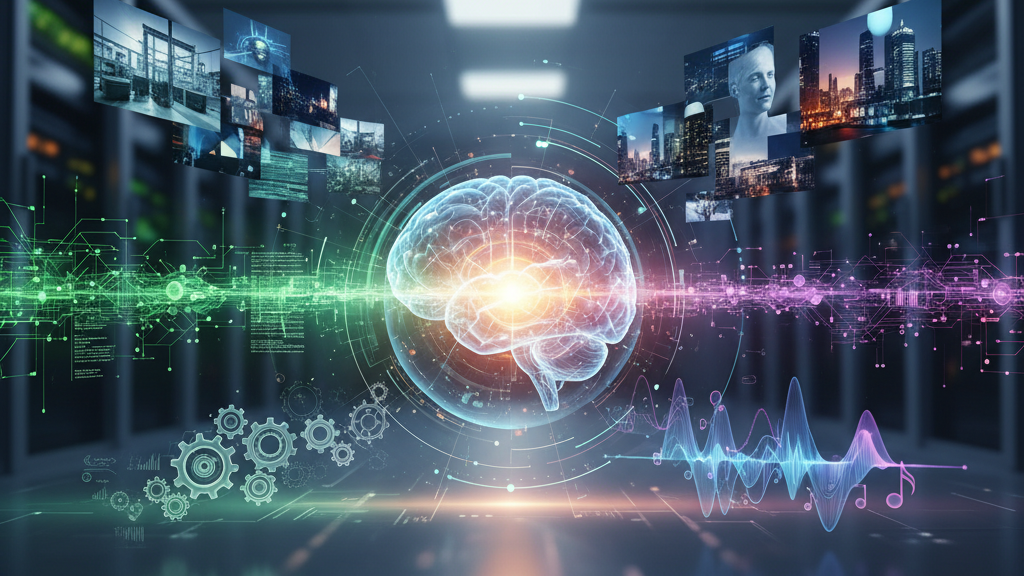The Strategic Imperative of Multimodal AI: From Data Chaos to Competitive Advantage
The global market for multimodal Artificial Intelligence (AI) is on an explosive growth trajectory, projected to reach $10.89 billion by 2030 at a compound annual growth rate of 36.8%.1 This surge is not driven by technological curiosity but by a pressing strategic need. Today’s enterprises are data-rich but insight-poor, a paradox created by the “multimodal gap” a profound disconnect between the vast, diverse data they collect and their ability to extract coherent, actionable intelligence from it.[3] While structured data and text have been the traditional focus of analytics, the most valuable information often lies trapped in unstructured formats: images from production lines, audio from customer service calls, video from safety inspections, and logs from IoT sensors.
This fragmentation creates dangerous blind spots in corporate decision-making. Multimodal AI agents represent the strategic solution to bridge this gap. These are not merely advanced analytics tools; they are a new operational paradigm. By processing and understanding the world as humans do synthesizing diverse sensory inputs, multimodal AI agents achieve a holistic, context-aware understanding that is impossible with single-modal systems.[4] The failure to adopt a data architecture that mirrors the complexity of the real world is a strategic vulnerability. Organizations that continue to build their future on an incomplete view of their own operations and customers risk being outmaneuvered by competitors who can see the full picture.
The C-Suite Guide to Multimodal AI: What it is and Why it Matters Now
Defining the Entity: What Are Multimodal AI Agents?
At its core, a multimodal AI agent is an intelligent system capable of processing, understanding, and acting upon information from multiple data types simultaneously, including text, images, audio, video, and sensor data.[4] For an executive, the distinction is critical: it is the difference between an analyst who can only read financial reports and one who can read the report, watch the factory floor video, listen to the customer service call, and see the satellite imagery of the supply chain. all at once, to form a single, coherent recommendation. These agents leverage sophisticated models to move beyond simple data processing to complex reasoning and autonomous action.[7]
How They Work: The Core Principles of Data Fusion
The power of multimodal AI stems from its ability to integrate these disparate data streams through a process of data fusion. This involves several key steps:
- Feature Extraction: Specialized neural networks (e.g., Convolutional Neural Networks for images, Transformers for text) are used to extract the essential features from each data type, or modality.[4]
- Alignment: The system then identifies connections between elements across different modalities, such as aligning spoken words with visual cues in a video.[4]
- Data Fusion: Finally, the aligned features are integrated into a unified, comprehensive representation. This can happen at different stages: early fusion combines raw data, mid fusion combines features during processing, and late fusion combines the outputs of separate models.[4] This fused data provides the rich context needed for advanced reasoning and decision-making.
What is the Strategic Advantage Over Traditional AI?
The move to multimodal AI offers three fundamental advantages over traditional, single-modal systems:
- Enhanced Contextual Understanding: By synthesizing information from multiple sources, multimodal systems dramatically reduce ambiguity and form a more complete picture of a situation. This is critical in complex environments like autonomous driving, where fusing data from video feeds, LiDAR, and GPS signals is essential for safety, or in supply chain management, where combining satellite imagery, weather data, and logistics reports can avert disruptions.[5]
- Superior Accuracy & Decision-Making: The ability to cross-reference data points leads to demonstrably better outcomes. In benchmark tasks like Visual Question Answering (VQA), which requires an AI to answer questions about an image, multimodal models can achieve accuracy rates exceeding 90%, significantly outperforming unimodal systems.5 This heightened accuracy translates directly into more reliable risk assessments, more precise quality control, and more effective customer targeting.
- Richer, More Human Interactions: Multimodal AI enables more natural and intuitive interfaces for both customers and employees. Virtual assistants that can process both spoken language and visual context can interpret user intent far more effectively, making interactions feel more fluid and human-like.[5] This leads to higher engagement, greater trust, and improved efficiency in service delivery.
Ultimately, the true competitive advantage is not just improved accuracy but cognitive scalability. Multimodal AI allows an organization to digitize and scale the holistic, multi-sensory reasoning of its best human experts. A seasoned physician, for instance, naturally synthesizes visual scans, written notes, and a patient’s tone of voice to make a diagnosis. Because these experts are a scarce resource, their impact is limited. Multimodal AI agents, by replicating this cognitive process, allow this high-level reasoning to be applied across the entire enterprise, 24/7, transforming core operations rather than merely optimizing them.

The ROI in Action: Quantifiable Wins from Multimodal Leaders
Across industries, early adopters are already translating multimodal capabilities into measurable financial and operational gains. These are not theoretical benefits; they are proven results impacting both the top and bottom lines.
Transforming Customer Experience & Driving Growth
- MetLife: In its call centers, the insurance giant deployed Cogito’s AI, which analyzes both the language and the tonal nuances of speech. This multimodal approach resulted in a 14-point increase in its Net Promoter Score (NPS), a 5% increase in “Perfect Call” scores, and a 17% reduction in average call handle time.[10]
- L’Oréal: The global beauty brand has leveraged multimodal AI to revolutionize its media and content creation pipeline. By analyzing visual trends, text-based consumer sentiment, and campaign performance data, L’Oréal has cut its creative concepting time from weeks to mere days, leading to faster speed-to-market and significant reductions in production costs.10
- Eye-oo: This retailer utilized multimodal AI to enhance its customer interactions, analyzing user behavior, search queries, and visual product engagement. The implementation led to an 86% reduction in customer wait times, a 25% increase in sales, and a five-fold boost in conversion rates.[11]
Achieving Operational Excellence & Mitigating Risk
- Siemens AG: The industrial manufacturing leader employs agentic AI to analyze real-time sensor data, acoustic patterns, and visual inspection feeds from its equipment. This holistic monitoring allows for highly accurate predictive maintenance, resulting in a 25% reduction in unplanned downtime and substantial efficiency gains.[12]
- Unilever: To optimize its cold-chain logistics, Unilever deployed AI models that ingest data from IoT temperature sensors, retail footfall analytics, and digital twin simulations. This improved demand forecast accuracy by 10-12%, which directly translated into a 5% reduction in perishable product waste.[13]
- JPMorgan: The financial services firm utilizes DocLLM, a specialized multimodal model that understands both the textual content and the visual layout of complex financial documents. This improves the accuracy and efficiency of document analysis for critical functions like risk evaluation, compliance, and contract review.[1]
Driving Breakthrough Innovation in R&D and Safety
- Google DeepMind & Moorfields Eye Hospital: In a landmark healthcare study, an AI model analyzed 3D retinal scans to detect over 50 different eye diseases with 94% accuracy, matching or exceeding the performance of leading human specialists and showcasing the technology’s diagnostic power.[12]
- Waymo: The autonomous vehicle pioneer is developing its EMMA (End-to-End Multimodal Model for Autonomous Driving) model using Google’s Gemini. This system processes a continuous stream of sensor data, including video feeds, lidar scans, and road signs, to generate future trajectories, enhancing the vehicle’s ability to navigate complex urban environments and avoid obstacles safely.[12]
The following table provides a scannable summary of the quantifiable impact of multimodal AI agents across various sectors.
Industry | Company | Application | Quantifiable ROI / Key Metric |
Financial Services | MetLife | Customer Service Call Analysis | +14 points in NPS, -17% handle time [10] |
Manufacturing | Siemens AG | Predictive Maintenance | -25% in unplanned downtime [12] |
Retail | Eye-oo | Customer Interaction | -86% in wait times, +25% in sales [11] |
Consumer Goods | L’Oréal | Content & Campaign Concepting | Concepting time cut from weeks to days [10] |
Healthcare | Google DeepMind | Medical Diagnostics | 94% accuracy in detecting 50+ eye diseases [12] |
Logistics | Unilever | Demand Forecasting | +10-12% in forecast accuracy, -5% product waste [13] |
Automotive | Waymo | Autonomous Driving | Enhanced navigation via multimodal sensor fusion [12] |

Navigating the Path to Implementation: A Framework for Enterprise Readiness
Despite its immense promise, deploying multimodal AI is far from a “plug-and-play” exercise.[12] Success requires a deliberate strategy that addresses three interconnected challenges. Failing to solve for one often leads to failure in the others, trapping promising initiatives in “pilot purgatory.”
The Foundational Challenge: Data Integration & Quality
The primary hurdle for most enterprises is data integration complexity. Combining text, images, audio, and sensor data requires a unified data architecture, a stark contrast to the siloed systems common in many organisations.[12] Furthermore, training accurate multimodal models demands massive, well-labelled datasets. The quality and relevance of this data are just as critical as the quantity, making data preparation the single biggest point of failure for many AI projects.[3]
The Resource Challenge: Infrastructure & Compute Costs
Multimodal AI workloads are resource-intensive. Running real-time analysis across multiple data streams often requires high-performance GPUs and a scalable cloud infrastructure.[12] These resources represent a substantial capital and operational expenditure. Without an efficient data pipeline, much of this expensive compute power can be wasted on processing low-quality or poorly integrated data.[5]
The Human Challenge: Bridging the Skill Gap
Successfully deploying and managing multimodal AI systems requires specialized talent in data science, machine learning engineering, and domain-specific applications. Many organizations face a significant skill gap in these areas, creating a bottleneck that can stall even the most well-funded initiatives.[10] This is not just an HR issue but a strategic workforce planning challenge that must be addressed for long-term success.
Conclusion: Your Roadmap from Multimodal Potential to Profitability
Multimodal AI is no longer a futuristic concept but a present-day competitive necessity. Industry leaders are already deploying these systems and reaping measurable rewards. For most organizations, the central obstacle is not a lack of ambition but the daunting complexity of making diverse, siloed enterprise data AI-ready in a secure, scalable, and cost-effective manner. This is the challenge that causes an estimated 95% of AI projects to fail before they reach production.[14]
This is precisely the problem Innoflexion’s DeepRoot ai platform was engineered to solve. DeepRoot is an enterprise-grade platform that provides the foundational layer needed to bridge the gap between multimodal ambition and reality. It directly addresses the core implementation challenges:
- AI Data Preparation & Data Readiness Index (DRI): DeepRoot tackles the #1 challenge of data integration head-on. Its tools transform messy, unstructured data from across the enterprise into structured, AI-optimised formats. The DRI provides a clear, quantifiable score of your data’s fitness for AI, identifying gaps and creating a roadmap for improvement.[16]
- Secure “Walled Garden” Environment: Addressing critical C-suite concerns, DeepRoot operates in a protected environment, available for on-premise or private cloud deployment. This ensures that your proprietary data is never exposed or used to train external models, eliminating the risk of data leakage [16]
- Agentic AI & Intelligent Orchestration: The platform provides the intelligence to automate complex, multi-step workflows. By coordinating multiple specialized AI agents, DeepRoot lowers the technical barrier for your existing teams, helping to bridge the skill gap and accelerate time-to-value.[16]
The gap between multimodal ambition and reality is bridged by a robust data foundation. Before you invest millions in computing power and data science teams, it is critical to assess your data readiness.
Ready to see what multimodal AI agents can unlock for your enterprise? Book a complimentary GenAI Readiness Audit with Innoflexion and receive your custom 90-day pilot roadmap today.
The journey into enterprise AI is constantly evolving, and the conversation doesn’t end here. I regularly share insights and analyses on navigating these complex technological shifts. I invite you to connect with me, Srini Belligundu, on LinkedIn to continue the discussion.
Reference
- Top 10 Innovative Multimodal AI Applications and Use Cases – Appinventiv, https://appinventiv.com/blog/multimodal-ai-applications/
- Multimodal AI Market Size And Share | Industry Report, 2030 – Grand View Research,https://www.grandviewresearch.com/industry-analysis/multimodal-artificial-intelligence-ai-market-report
- Fascinating Multimodal AI Applications for Enterprises – CloudFactory, https://www.cloudfactory.com/blog/fascinating-multimodal-ai-applications-for-enterprises
- What is Multimodal AI? | IBM, https://www.ibm.com/think/topics/multimodal-ai
- What is Multimodal AI? [10 Pros & Cons] [2025] – DigitalDefynd, https://digitaldefynd.com/IQ/multimodal-ai-pros-cons/
- aws.amazon.com,https://aws.amazon.com/blogs/machine-learning/generative-ai-and-multi-modal-agents-in-aws-the-key-to-unlocking-new-value-in-financial-markets/#:~:text=Multi%2Dmodal%20agents%20are%20AI,understanding%20and%20generate%20appropriate%20responses.
- 23 Agentic AI Definitions for Business Users – Salesforce, https://www.salesforce.com/blog/agentic-ai-definitions/
- AI Agent Use Cases | IBM, https://www.ibm.com/think/topics/ai-agent-use-cases
- The Future of AI: How Multimodal AI is Driving Innovation, https://www.testingmind.com/the-future-of-ai-how-multimodal-ai-is-driving-innovation/
- How Multimodal AI Is Transforming Business and Customer, https://www.designrush.com/agency/ai-companies/trends/multimodal-ai-models
- 17 Useful AI Agent Case Studies – Multimodal, https://www.multimodal.dev/post/useful-ai-agent-case-studies
- Understanding Multimodal AI Agents in Intelligent Systems, https://www.ema.co/additional-blogs/addition-blogs/understanding-multimodal-ai-agents
- Top 8 use cases of Artificial Intelligence in logistics – ShippyPro Blog, https://www.blog.shippypro.com/en/ai-logistics-use-cases
- Beyond the Hype: Why 95% of AI Projects Fail and How to Be in the 5% That Succeeds,https://www.innoflexion.com/blog/why-ai-projects-fail-blueprint
- generative ai Archives – Innoflexion, https://www.innoflexion.com/blog/tag/generative-ai
- Empowering Innovation with Generative AI Solutions – Innoflexion, https://www.innoflexion.com/genai

